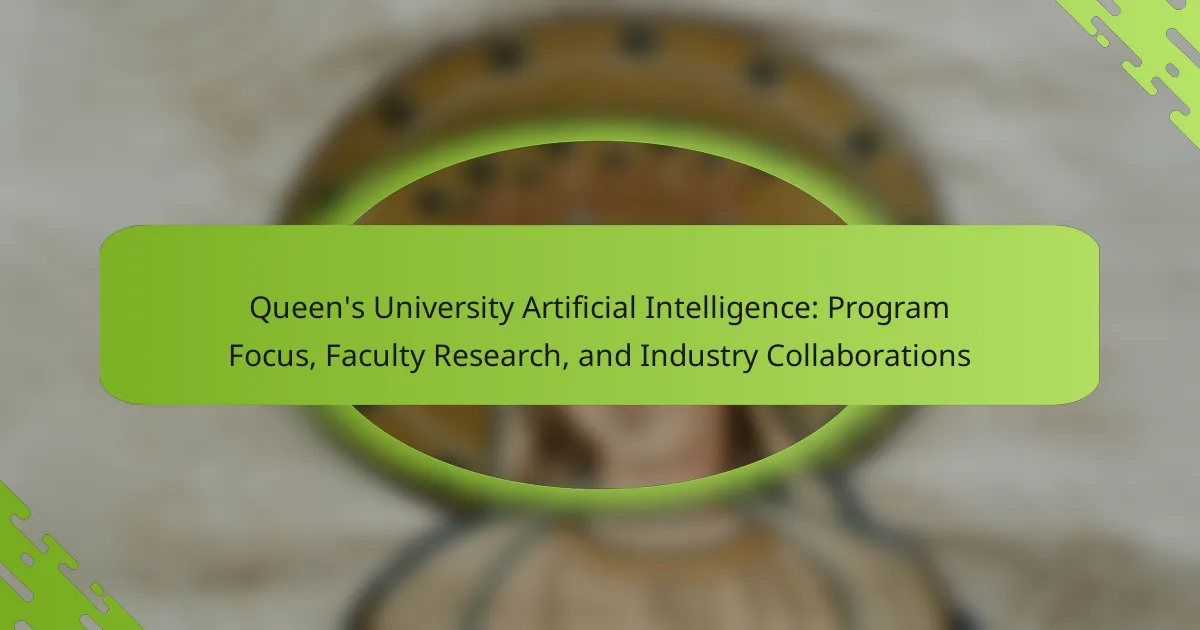The University of Manitoba’s IT infrastructure encompasses a variety of technologies and services designed to support both academic and administrative functions. Key components include network systems, data centers, and cloud services, all of which provide high-speed internet access throughout the campus. The university employs advanced security measures to safeguard data and systems while offering a range of software applications for students and faculty. Additionally, the IT department delivers technical support and training, all of which contribute to enhancing the educational experience and preparing students for future career pathways in technology.

What is the IT Infrastructure at the University of Manitoba?
The IT infrastructure at the University of Manitoba includes a range of technologies and services. It supports academic and administrative functions. The infrastructure consists of network systems, data centers, and cloud services. High-speed internet access is available across the campus. The university employs modern security measures to protect data and systems. Additionally, it offers various software applications for students and faculty. The IT department provides technical support and training. These elements work together to enhance the educational experience at the university.
How is the IT Infrastructure structured at the University of Manitoba?
The IT infrastructure at the University of Manitoba is structured around a centralized management system. This system integrates various technologies to support academic and administrative functions. Key components include data centers, network services, and user support systems. The university employs a robust network infrastructure that connects multiple campuses. This infrastructure supports both wired and wireless connectivity. Data storage solutions are implemented to ensure secure and efficient access to information. Additionally, cloud services are utilized for scalability and flexibility. The IT department provides ongoing support and training for users, enhancing overall functionality.
What are the key components of the IT Infrastructure?
The key components of IT infrastructure include hardware, software, networking, and data storage. Hardware encompasses physical devices like servers, computers, and networking equipment. Software consists of operating systems, applications, and management tools that facilitate operations. Networking involves the systems that connect hardware and enable communication, including routers and switches. Data storage refers to solutions for storing and managing data, such as databases and cloud storage. These components work together to support IT services and operations effectively.
How does the IT Infrastructure support academic programs?
IT infrastructure supports academic programs by providing essential technological resources and services. It enables access to online learning platforms and digital libraries. High-speed internet connectivity facilitates research and collaboration among students and faculty. Reliable servers host course materials and student information systems. Virtual labs allow hands-on learning experiences in a controlled environment. IT support ensures that technical issues are resolved quickly, minimizing disruptions. Data analytics tools assist in tracking student performance and improving educational outcomes. Overall, a robust IT infrastructure enhances the learning experience and academic success.
What technologies are utilized in the University of Manitoba’s IT Infrastructure?
The University of Manitoba’s IT infrastructure utilizes various technologies including cloud computing, networking equipment, and data management systems. Cloud computing services enhance resource accessibility and scalability. Networking equipment ensures reliable connectivity across campus. Data management systems support the storage and retrieval of academic and administrative information. These technologies facilitate efficient operations and support the university’s educational mission.
What are the primary software tools used in the IT Infrastructure?
The primary software tools used in IT infrastructure include virtualization software, network management tools, and database management systems. Virtualization software like VMware and Hyper-V enables the creation of virtual machines. Network management tools such as SolarWinds and Nagios monitor and manage network performance. Database management systems like MySQL and Oracle facilitate data storage and retrieval. These tools are essential for maintaining efficient and secure IT environments. Their use is widely recognized in the industry for optimizing resources and improving system reliability.
How do networking technologies enhance the IT Infrastructure?
Networking technologies enhance IT infrastructure by improving connectivity and communication. They enable seamless data transfer between devices and systems. This results in increased operational efficiency. Networking technologies also provide scalability to accommodate growth. They support various applications and services, enhancing user experience. Moreover, they ensure security through advanced protocols and encryption methods. Statistics show that organizations with robust networking technologies experience fewer downtime incidents. This leads to higher productivity and better resource management.
What role does hands-on learning play in the IT programs at the University of Manitoba?
Hands-on learning is integral to the IT programs at the University of Manitoba. It enhances students’ practical skills and knowledge in real-world scenarios. The curriculum incorporates labs, projects, and simulations. These experiences allow students to apply theoretical concepts in practice. Students engage with current technologies and tools used in the industry. This approach prepares graduates for the demands of the job market. Research indicates that experiential learning significantly improves retention and understanding. Therefore, hands-on learning fosters both competence and confidence in IT students.
How are students engaged in practical IT projects?
Students engage in practical IT projects through hands-on learning experiences. These projects often involve real-world applications of IT concepts. Students collaborate in teams to solve technical problems. They utilize key technologies relevant to the industry. Faculty members guide students throughout the projects. Assessments are based on project outcomes and teamwork skills. This approach enhances both technical and soft skills. Research shows that practical experience increases employability in IT fields.
What facilities are available for hands-on learning in IT?
The University of Manitoba offers several facilities for hands-on learning in IT. These include dedicated computer labs equipped with the latest software and hardware. Students have access to virtual labs that simulate real-world IT environments. The institution also provides networking labs for practical experience in network setup and management. Additionally, there are collaborative workspaces designed for group projects and innovation. Workshops and seminars are regularly held to enhance practical skills. Furthermore, students can engage in internships that provide real industry experience. These facilities support a comprehensive learning experience in IT.
How does the IT Infrastructure prepare students for career pathways?
The IT infrastructure at the University of Manitoba equips students for career pathways through practical experience and access to advanced technologies. Students engage with real-world IT systems, enhancing their technical skills. The infrastructure supports hands-on learning in areas such as networking, cybersecurity, and data management. This experiential learning is critical for building competencies that employers value. According to a study by the National Center for Education Statistics, students with practical experience are 40% more likely to secure employment after graduation. Furthermore, the university collaborates with industry partners, providing students with networking opportunities and internships. These connections facilitate smoother transitions into the workforce. Overall, the IT infrastructure fosters a comprehensive learning environment that prepares students for successful careers in technology.
What career opportunities are available for graduates of IT programs?
Graduates of IT programs have a variety of career opportunities available to them. Common roles include software developer, network administrator, and cybersecurity analyst. They can also work as data analysts, systems analysts, and IT project managers. Many graduates find positions in technical support and IT consulting. The demand for IT professionals continues to grow, with the Bureau of Labor Statistics projecting a 22% increase in employment for IT occupations from 2020 to 2030. This growth highlights the importance of IT skills in various industries. Additionally, graduates can pursue roles in emerging fields such as cloud computing and artificial intelligence. These opportunities reflect the broad applicability of IT skills in today’s job market.
How does the University of Manitoba support student internships and job placements?
The University of Manitoba supports student internships and job placements through dedicated career services. These services include job fairs, resume workshops, and interview preparation sessions. The university partners with local businesses and organizations to create internship opportunities. Students can access an online job portal that lists internship and job openings. Faculty members also assist students in finding relevant positions in their fields. Additionally, the university promotes experiential learning through co-op programs. These initiatives help students gain practical experience and enhance employability. Data indicates that over 70% of students secure internships through these resources.
What are some best practices for leveraging the University of Manitoba IT Infrastructure for career success?
Utilize the University of Manitoba IT Infrastructure by engaging in hands-on learning opportunities. Participate in workshops and training sessions offered by the IT department. Access online resources and tools provided by the university to enhance technical skills. Collaborate with peers on IT projects to gain practical experience. Network with industry professionals through university events and career fairs. Seek internships or co-op placements that utilize university IT resources. Leverage the university’s career services for job search assistance and resume building. Engage with faculty members for mentorship and guidance in your career path.
The main entity of this article is the IT infrastructure at the University of Manitoba. The article provides an overview of the university’s IT infrastructure, detailing its components such as network systems, data centers, and cloud services, which support both academic and administrative functions. It emphasizes the importance of hands-on learning in IT programs, highlighting the facilities and technologies that enhance student engagement and career readiness. Additionally, the article outlines how the IT infrastructure prepares students for various career pathways in technology and the support systems in place for internships and job placements.



